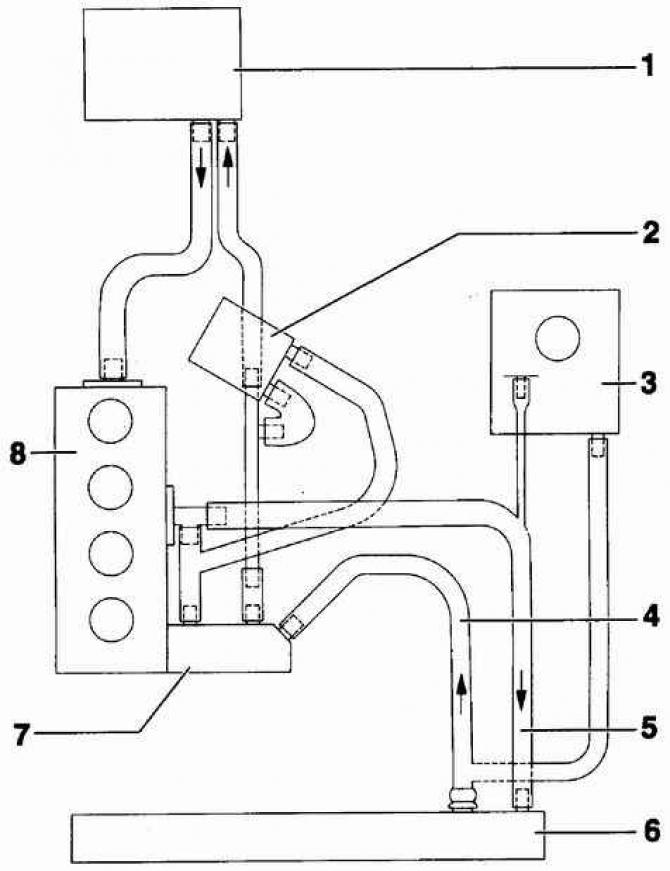Elements of the engine cooling system 1.6-I / 1.8-I

- 1 - heater radiator;
- 2 - return pipeline;
- 3 - throttle body;
- 4 - expansion tank;
- 5 - oil heat exchanger;
- 6 - intake manifold;
- 7 - upper radiator hose;
- 8 - lower radiator hose;
- 9 - radiator;
- 10 - coolant supply pipeline;
- 11 - water pump / thermostat;
- 12 - cylinder head / engine block;
- 13 - connecting pipe
Elements of the diesel engine cooling system

- 1 - heater radiator;
- 2 - oil heat exchanger;
- 3 - expansion tank;
- 4 - upper radiator hose;
- 5 - lower radiator hose;
- 6 - radiator;
- 7 - water pump;
- 8 - engine block
Units of the engine cooling system 1.8-I

- 1 - screw, 20 Nm;
- 2 - lower casing of the toothed belt;
- 3 - sealing ring. At installation it is necessary to use a new sealing ring;
- 4 - water pump. The thermostat is located in the water pump housing;
- 5 - oil heat exchanger mounted on the oil filter holder;
- 6 - fixing brackets;
- 7 - electrical connector;
- 8 - coolant temperature sensor. The coolant temperature sensor is designed for the engine management system and temperature gauge;
- 9 - plug;
- 10 - to the heater radiator;
- 11 - connecting pipe;
- 12 - bolt, 10 Nm;
- 13 - pipeline for coolant;
- 14 - throttle body;
- 15 - from the heater radiator;
- 16 - pipeline for coolant;
- 17 - cover;
- 18 - sealing ring;
- 19 - expansion tank;
- 20 - hose for coolant;
- 21 - bracket. The bracket is designed for fastening the poly V-belt tensioner, radiator fan viscous coupling, power steering pump impeller and generator.
- 22 - belt;
- 23 - radiator fan impeller
Fan and radiator of cars with four-cylinder engines

- 1 - impeller;
- 2 - viscous coupling;
- 3 - pulley;
- 4 - bracket;
- 5 - front cross member;
- 6 - radiator curtain;
- 7 - seal;
- 8 - radiator
The sealed type cooling system includes a water pump driven by an auxiliary drive belt, a radiator fan with a thermoviscous coupling, a radiator, an expansion tank, a thermostat and a heater radiator, as well as hoses and switches. When starting a cold engine, coolant circulates around the cylinder block and cylinder head. The warm coolant flows through the heater core to the water pump. Since the coolant expands when heated, its level in the expansion tank rises. The flow of coolant through the radiator is closed, which provides a closed thermostat. When the coolant reaches a predetermined temperature, the thermostat opens and hot coolant flows through the hose to the radiator, as the coolant passes through the radiator, it is cooled by the flow of oncoming air. The thermoviscous radiator fan clutch is activated depending on the air temperature behind the radiator. When the predetermined temperature is reached, the valve in the clutch opens and the thermoviscous clutch drives the fan impeller. When the coolant temperature is in the range from +92°C to +98°C, the temperature sensor turns on the first stage of the radiator fan and the fan rotates at a reduced speed. When the coolant temperature is from +99°C to +105°C, the temperature sensor turns on the radiator fan to the second stage and the fan rotates at the maximum number of revolutions.
The electrically driven fan may also turn on after the ignition is turned off. Therefore, when working on a hot engine, it is necessary to disconnect the electrical connector from the fan motor for the duration of the work.
Warning: When opening the expansion tank cap on a hot engine, care must be taken as escaping vapors can cause severe burns. To do this, close the cap of the expansion tank with a thick layer of cloth and slowly unscrew the cap until a hissing sound is heard. After the hiss stops, slowly unscrew and remove the cap from the expansion tank.
Warning: Do not allow coolant to come into contact with clothing or body paintwork. Otherwise, rinse the surface with plenty of water.

Visitor comments